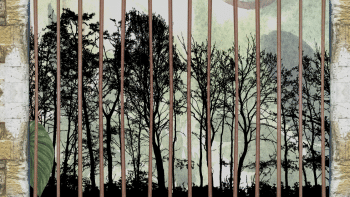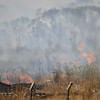The ‘War on Trees’ is winning

Unlike the "War on Terror," a script written and executed by US President George W Bush, the "War on Trees" has been far more successful.
The War on Terror actually perpetuated terror by unleashing unprecedented violence on civilian populations, when the US decided that it would have to bomb Iraq to smithereens to combat the threat of mythical weapons of mass destruction. The War on Terror has not made the world any safer; it can be argued that human populations are even more vulnerable to terror in many guises and forms as a result of it. Terror keeps multiplying like a crazy virus.
The war on trees, meanwhile, is straightforward and simple. It does exactly what it says – attacks the trees, killing them and its residents along with it – no fuss, no frills.
The latest "kill" was in Habiganj's Chunarughat, on a land leased by Hatimara Tea Garden. It was a land full of trees – many around a hundred years old – and home to many kinds of wildlife. There were barking deer, Indian civets, langurs, apes, mynas, herons, squirrels, and so on. Near it was the Rema-Kalenga Wildlife Sanctuary.
According to a report by The Daily Star's Sylhet correspondent, a horrible tragedy unfolded on January 19. The tea estate decided they needed to expand the tea garden. To do so, they began to "clear" the land – by setting the trees on fire, with all the animals and birds still present. It was their land, and they could do whatever they liked with it.
Unsurprisingly, the fire spread to the sanctuary, increasing the death toll – though "officially," there is no such thing. Three days passed but no one from the local administration, not a single forest official, came to stop the fire as living beings screamed their death cries. Around 140 trees were cut down and burnt. Operation Clear Forest was successful!
No doubt, most of the traces of this crime have been cleverly covered up. The dead bodies of animals and birds, that our correspondent saw himself, have probably been buried or turned to ash, along with the trees. The tea estate representatives can shrug their shoulders and say that they own the land, end of story.

But is there no law that states that you cannot just cut down trees and burn them, along with all the wildlife in them? What about the Wildlife (Preservation and Security) Act 2012, created to monitor and protect wildlife, and the laws against violating sanctuary rules?
The constitution mandates the state to protect all wildlife. Not that the constitution has stopped anyone from grabbing land, encroaching on river banks, filling up water bodies, and destroying the habitats of thousands of animals and birds before. Which makes it easy for various government agencies and development projects to also take up pieces of the pie – or, in this case, forest. According to reports, this amounts to about 1.65 lakh acres of forestland. The results are balding forests in Cumilla, Gazipur, Mymensingh, Tangail, and more.
Reserve forests, in fact, are the prime targets of this war on trees. Don't forget the various forms of "essential construction" approved by the government, which involve felling hundreds and thousands of trees.
Think of the 20 acres of a reserve forest in Ramu, given to the Bangladesh Football Federation (BFF) to build a residential training facility. Recall the image of stumps of freshly cut trees in one of the remote forests of Bhola's Manpura Island to fuel brick kilns. Imagine the reality if the Roads and Highways Department succeeds in getting the 174 acres of the Ramgarh-Sitakunda Reserve Forest in Chattogram – one of the oldest reserve forests in the country – to widen a road going through it. Dread the catastrophic effects on the Sundarban mangrove forest when the Rampal Power Plant is in full operation, along with over a hundred industrial projects close by.
The war on trees has been kept alive and kicking in our cities, too. Chattogram has lost half of its greenery to real estate development. Dhaka's concrete jungle has eaten away thousands of trees, leaving wild animals and birds homeless and lost. Monkeys attacking city dwellers and desperately looking for food, dwindling bird populations, and no respite, for animals and humans alike, from the glaring sun and choking smog – all a result of this insatiable desire to obliterate any kind of greenery in sight if it comes in the way of urban development. Which is why your neighbour may send an assassin at an unholy hour to saw off your cherished krishnachura tree. It is why housing projects will involve taking up every bit of the land, shaving off the original trees, and leaving no space for new ones to be planted.
In Singapore, wilfully destroying a tree can lead to a fine of up to 10,000 Singapore dollars. Even if the tree (to be felled) is within one's own property, applications have to be made to the government body concerned, stating the reasons why the tree must be cut. Closer to home, Hyderabad has become the only city in India to be given the distinction of being a "Tree City of the World" by Arbor Day Foundation and the Food and Agriculture Organization (FAO).
So why are we on this suicidal path while cheerleading environmental conservation abroad? How have we forgotten why we need our trees, our forests that shield us from cyclones and tsunamis, that give shelter to precious wildlife and absorb the toxic carbon we so copiously produce? Why are we so fixated on this insane war on trees?
Aasha Mehreen Amin is joint editor at The Daily Star.

 For all latest news, follow The Daily Star's Google News channel.
For all latest news, follow The Daily Star's Google News channel. 









Comments